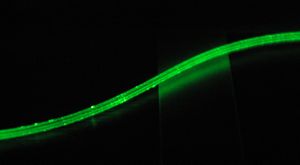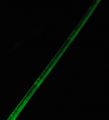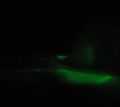Difference between revisions of "Laser Images"
| Line 35: | Line 35: | ||
==Damage from Clamp== | ==Damage from Clamp== | ||
| + | |||
| + | The pictures below all reveal a band of damage near the clamped end of the spooled light guide. This discovery is important: if a weak foam-lined clamp (chip-clip style) can cause this damage, then one must wonder about other potential mishandling. I have observed hook-and-loop ties used to store fiber bundles, fibers laid across tables, fibers laid over sandpaper (quickly moved when pointed out), and fibers rubbing against other fibers. I hypothesize that the sharp edges of the square guides are most prone to damage, but that all procedures for manipulating fibers are leaving marks. Pictures of the chip-clip and the hook-and-loop fasteners to come. | ||
<gallery> | <gallery> | ||
Revision as of 02:33, 29 January 2016
Used Fibers
Light Loss Along Length
I took the segments of wave guide that I had examined under microscope and exposed them to a green laser pointer with very little ambient light. The laser illuminated the wave guide and revealed the effects of surface damage. Areas with fissures, dust, or residue sparkled under the green light. This indicates significant light loss. Understanding light loss is key to the success of the tagger microscope.
Surface Imperfections
Details of the damage are visible in these pictures.
Figure 2: In the upper right-hand third of the image are two parallel bands outlining a section of wave guide that seems brighter. This corresponds to the glue residue from the sticky labeling system. Other damage can also be seen.
Figure 3: Nicks, gouges, and residues coat the length of the fiber, causing light loss everywhere.
New Fibers
Clarity
Freshly cut light guide demonstrates remarkable clarity and minimal light loss. These images illustrate the smoothness of an undamaged surface.
Damage from Clamp
The pictures below all reveal a band of damage near the clamped end of the spooled light guide. This discovery is important: if a weak foam-lined clamp (chip-clip style) can cause this damage, then one must wonder about other potential mishandling. I have observed hook-and-loop ties used to store fiber bundles, fibers laid across tables, fibers laid over sandpaper (quickly moved when pointed out), and fibers rubbing against other fibers. I hypothesize that the sharp edges of the square guides are most prone to damage, but that all procedures for manipulating fibers are leaving marks. Pictures of the chip-clip and the hook-and-loop fasteners to come.











